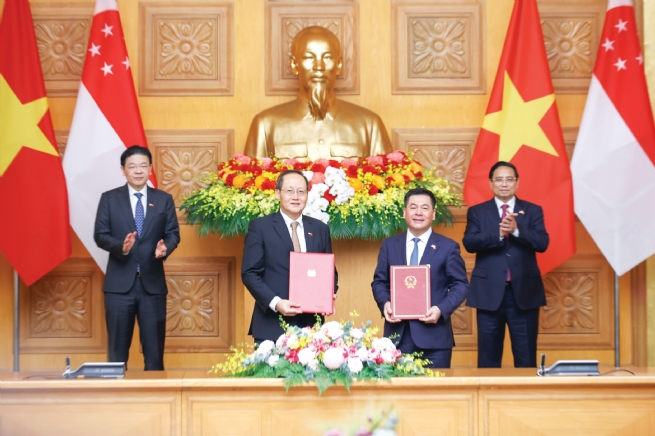Vietnam-Singapore Trade Ties: Ample Room for Growth
Economic ties between Vietnam and Singapore have witnessed significant progress, as evidenced by bilateral trade that has consistently set new records. Vietnam is currently Singapore’s 10th largest trading partner while the Lion City has long been one of Vietnam’s key markets in Southeast Asia.

Soaring trade value, with balanced growth on both sides
The bilateral merchandise trading value totaled US$10.5 billion in 2024. In the first half of 2025, this figure surged to US$14.4 billion. Singapore’s exports to Vietnam hit US$10.3 billion, up 24.4%, while Vietnam’s shipments to Singapore valued US$4.1 billion, up 40.1%.
In June 2025 alone, total bilateral trade stood at US$2.4 billion, representing a 30.4% year-on-year growth. This illustrated the flexible and effective policy coordination of relevant authorities and businesses on both sides.
The structure of merchandise imports and exports between the two economies demonstrates a high degree of complementarity. Vietnam mainly exports machinery, electronic components, transport means, processed foods, and agricultural products to Singapore. In return, Singapore supplies Vietnam with petroleum, petrochemical products, high-tech equipment, and consumer goods.
Machinery and electrical equipment from Vietnam topped the export list with a value of US$2 billion, growing 80.7% year on year and accounting for nearly 50% of total exports to Singapore. In the seafood sector, Vietnam surpassed Norway to become Singapore’s third-largest supplier, with an export value of US$44.7 million, up 10.8%.
For agricultural products, Vietnam holds a 24.5% share of Singapore’s rice imports, worth US$47.5 million. White rice alone accounted for US$30.1 million, up 11.9%, showing that Vietnamese companies’ efforts to enhance quality and meet consumer tastes are yielding positive results.
On the other hand, Singapore continues to be a transshipment hub and high-tech supplier for the Vietnamese market. Machinery and electrical equipment reached US$5.3 billion, up 30.1%, while minerals and fuels amounted to US$1.7 billion, up 24.7%. Notably, 97.4% of the goods in these groups were re-exports, reaffirming Singapore’s role as a strategic logistics and trade hub in the Asia-Pacific region.
Challenges and opportunities
Despite the positive outcomes in bilateral trade cooperation, Vietnamese businesses still face numerous challenges in penetrating the Singaporean market, one of the most demanding in Asia. With stringent regulations on quality, food safety, and technical standards, especially for consumer goods and food products, only those that strictly meet these requirements will have a chance for sustainable penetration.
Beyond technical barriers, Vietnamese businesses also face intense regional competition. Countries like Malaysia, Indonesia, Thailand, and India share similar strengths in seafood and rice, two sectors where Vietnam traditionally has strengths, leading to direct competition for market shares. Additionally, high domestic production costs, inadequate investment in packaging, and weak branding are also weaknesses that make it harder for Vietnamese goods to break through in this market.
Nevertheless, these challenges also reveal many valuable opportunities. Vietnam-Singapore trade relations are poised for further growth, underpinned by mutual trust and complementary cooperation foundation. Both countries can deepen cooperation in high-tech supply chains, electronics, and energy - sectors where Singapore plays a central role in the Asia-Pacific region.
A notable bright spot is Singapore’s role as a gateway to the global Halal market. This represents a potential opportunity for Vietnamese agricultural products and processed foods to reach hundreds of millions of consumers if they meet international Halal standards. Along with this, emerging areas such as renewable energy, digital transformation, and information technology are opening up new avenues for cooperation, consistent with the sustainable development orientation that both countries are pursuing.
Singapore’s positive economic outlook is also a favorable factor for Vietnamese goods. In the second quarter of 2025, Singapore's economy grew by 4.3%, buttressed by steady growth in manufacturing (5.5%), construction (4.9%), and wholesale-retail (4.8%). The strong rebound in domestic consumption, along with growing supply diversification, is boosting import demand from strategic partners like Vietnam, particularly for high-quality food and seafood products.
Free trade agreements such as the Comprehensive and Progressive Agreement for Trans-Pacific Partnership (CPTPP), the Regional Comprehensive Economic Partnership (RCEP), and the ASEAN Free Trade Area (AFTA) continue to play important catalysts for boosting bilateral trade, through tariff reductions and simplified trade procedures. To effectively capitalize on these advantages, Vietnamese businesses need to enhance their competitiveness, improve value chains, and proactively adapt to international standards.
Mr. Cao Xuan Thang, Vietnamese Trade Counselor in Singapore, advised businesses to actively stay updated on market information, invest in modern production technologies, improve packaging designs, and build professional brands to uplift their positions in this market. The Vietnamese Trade Office in Singapore is committed to supporting businesses by connecting trade, organizing exhibitions, promoting products, and facilitating investment.








